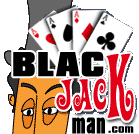

QUICK LINKS
Home
Play Our Game
Rules | Strategies
Terms & Definitions
Bigger Winnings
Online Poker
WEBMASTERS
Make Money
Newbies | Resources

|

Shuffle tracking
Shuffle tracking is a technique that doesn't get a lot of attention. It is the science of following specific cards through the shuffling process, for the purpose of either keeping them in play, or cutting them out of play.
Of course, shuffling a deck of cards does not mean that the cards are "randomized". (According to some authors, a single deck of cards must be shuffled twenty to thirty times to ensure a truly random dispersion. If a casino is using an eight-deck shoe, that's 160 to 240 shuffles!)
A beneficial (to the player) shuffle for a one deck game is executed by dividing the deck equally into 26 cards and shuffling them together a minimum of three times. This allows the cards to be sufficiently intermixed to yield a fairly random distribution. An adverse shuffle prevents the cards from mixing completely.
Some dealers will unknowingly split the deck into unequal stacks. However, more often than not, they are required to split the deck into unequal stacks. If they are required to do this, they are performing the House Shuffle. The casino has trained the dealer to shuffle a particular way... on purpose! Why? In the long run, the house will benefit from this because most players will not cut any bad clumps out of play. If you have played blackjack in a casino, how closely did you watch the way they shuffled?
There are a number of shuffle methods. The Zone Shuffle is particular to shoe games (multiple deck games) and is probably one of the most common shuffle methods. It is accomplished by splitting the shoe into four to eight piles depending on the number of decks in the shoe. Prescribed picks from each pile are made in a very exact way with intermittent shuffles of each pair of half deck sized stacks. The net effect is a simple regrouping of the cards pretty much in the same region of the shoe as they were before, thereby preventing clumps of cards from being randomly mixed. If the dealer won 40 hands and you won 20, this trend is likely to continue until you are broke or until the unfavorable bias is removed through many shuffles.
What if the players are winning the 40 hands and the dealer only 20? If the dealer has been mentally keeping track of how many hands each side has won in the shoe, the dealer will probably do one of two things. One is to keep the shuffle the same, but 'strip' the deck. When a dealer strips a deck, he/she strips off one card at a time from the shoe letting them fall on top of one another onto the table. This action causes the order of the cards to be reversed. The main consequence is to dissipate any clumping advantages (a bunch of tens in a clump) that the players may have. The second thing the dealer may do is simply change the way they shuffle to help randomize the cards.

[ HOME ] [ ] [ PLAY OUR GAME ]
|




